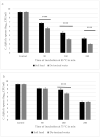Efficacy of Dry Heat Treatment against Clostridioides difficile Spores and Mycobacterium tuberculosis on Filtering Facepiece Respirators
- PMID: 36014991
- PMCID: PMC9415841
- DOI: 10.3390/pathogens11080871
Efficacy of Dry Heat Treatment against Clostridioides difficile Spores and Mycobacterium tuberculosis on Filtering Facepiece Respirators
Abstract
The COVID-19 pandemic has required novel solutions, including heat disinfection of personal protective equipment (PPE) for potential reuse to ensure availability for healthcare and other frontline workers. Understanding the efficacy of such methods on pathogens other than SARS-CoV-2 that may be present on PPE in healthcare settings is key to worker safety, as some pathogenic bacteria are more heat resistant than SARS-CoV-2. We assessed the efficacy of dry heat treatment against Clostridioides difficile spores and Mycobacterium tuberculosis (M. tb) on filtering facepiece respirator (FFR) coupons in two inoculums. Soil load (mimicking respiratory secretions) and deionized water was used for C. difficile, whereas, soil load and PBS and Tween mixture was used for M. tb. Dry heat treatment at 85 °C for 240 min resulted in a reduction equivalent to 6.0-log10 CFU and 7.3-log10 CFU in C. difficile spores inoculated in soil load and deionized water, respectively. Conversely, treatment at 75 °C for 240 min led to 4.6-log10 CFU reductions in both soil load and deionized water. C. difficile inactivation was higher by >1.5-log10 CFU in deionized water as compared to soil load (p < 0.0001), indicating the latter has a protective effect on bacterial spore inactivation at 85 °C. For M. tb, heat treatment at 75 °C for 90 min and 85 °C for 30 min led to 8-log10 reduction with or without soil load. Heat treatment near the estimated maximal operating temperatures of FFR materials (which would readily eliminate SARS-CoV-2) did not achieve complete inactivation of C. difficile spores but was successful against M. tb. The clinical relevance of surviving C. difficile spores when subjected to heat treatment remains unclear. Given this, any disinfection method of PPE for potential reuse must ensure the discarding of any PPE, potentially contaminated with C. difficile spores, to ensure the safety of healthcare workers.
Keywords: COVID-19; PPE; SARS-CoV-2; bacteria; deionized water; disinfection; healthcare workers; inactivation; personal protective equipment; reuse; soil load.
Conflict of interest statement
The authors declare no conflict of interest.
Figures





Similar articles
-
Ultraviolet-C Irradiation, Heat, and Storage as Potential Methods of Inactivating SARS-CoV-2 and Bacterial Pathogens on Filtering Facepiece Respirators.Pathogens. 2022 Jan 10;11(1):83. doi: 10.3390/pathogens11010083. Pathogens. 2022. PMID: 35056031 Free PMC article.
-
Aerosolized Hydrogen Peroxide Decontamination of N95 Respirators, with Fit-Testing and Viral Inactivation, Demonstrates Feasibility for Reuse during the COVID-19 Pandemic.mSphere. 2022 Oct 26;7(5):e0030322. doi: 10.1128/msphere.00303-22. Epub 2022 Aug 30. mSphere. 2022. PMID: 36040048 Free PMC article.
-
In vitro production of Clostridium difficile spores for use in the efficacy evaluation of disinfectants: a precollaborative investigation.J AOAC Int. 2011 Jan-Feb;94(1):259-72. J AOAC Int. 2011. PMID: 21391503
-
A Practical Approach to Filtering Facepiece Respirator Decontamination and Reuse: Ultraviolet Germicidal Irradiation.Curr Treat Options Infect Dis. 2021;13(2):35-46. doi: 10.1007/s40506-021-00247-8. Epub 2021 Apr 6. Curr Treat Options Infect Dis. 2021. PMID: 33841050 Free PMC article. Review.
-
[Limited Reuse and Extended Use of Filtering Facepiece Respirators].Enferm Clin. 2021 Feb;31:S78-S83. doi: 10.1016/j.enfcli.2020.05.012. Epub 2020 May 21. Enferm Clin. 2021. PMID: 34629854 Free PMC article. Review. Spanish.
Cited by
-
Targeting the Impossible: A Review of New Strategies against Endospores.Antibiotics (Basel). 2023 Jan 26;12(2):248. doi: 10.3390/antibiotics12020248. Antibiotics (Basel). 2023. PMID: 36830159 Free PMC article. Review.
References
-
- Derraik J.G.B., Anderson W.A., Connelly E.A., Anderson Y.C. Rapid review of SARS-CoV-1 and SARS-CoV-2 viability, susceptibility to treatment, and the disinfection and reuse of PPE, particularly filtering facepiece respirators. Int. J. Environ. Res. Public Health. 2020;17:6117. doi: 10.3390/ijerph17176117. - DOI - PMC - PubMed
-
- Harfoot R., Yung D.B., Anderson W.A., Wild C.E., Coetzee N., Hernández L.C., Lawley B., Pletzer D., Derraik J.G., Anderson Y.C. Ultraviolet-C irradiation, heat, and storage as potential methods of inactivating SARS-CoV-2 and bacterial pathogens on filtering facepiece respirators. Pathogens. 2022;11:83. doi: 10.3390/pathogens11010083. - DOI - PMC - PubMed
-
- Rutala W.A., Weber D.J. Guideline for Disinfection and Sterilization in Healthcare Facilities. [(accessed on 30 June 2022)];2008 Available online: https://stacks.cdc.gov/view/cdc/47378.
-
- Shirey B.T., Schubert W., Benardini J. An overview of surface heat microbial reduction as a viable microbial reduction modality for spacecraft surfaces; Proceedings of the 47th International Conference on Environmental Systems (ICES); Charleston, SC, USA. 16–20 July 2017.
LinkOut - more resources
Full Text Sources
Miscellaneous

